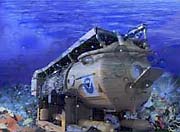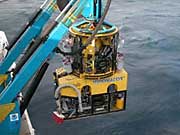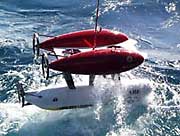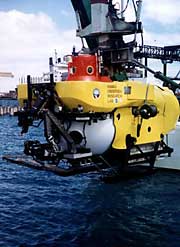
skip to content program navigation
| Learn more about these OCEAN and COASTAL RESEARCH areas... |
More OCEAN EXPLORATION and UNDERSEA RESEARCH topics:
Ocean Exploration and Undersea Research
Technologies and Capabilities for Ocean Research and Exploration
Background
NOAA's various missions in coastal and ocean waters depend on technology.
It is only in the past half century that technology has advanced to the
point that we can examine the oceans in systematic, scientific and noninvasive
ways. The changing and difficult study of the ocean realm requires new
intellectual approaches and a national investment in a new mode of conducting
marine investigations. With the exception of advanced synoptic remote
sensing technologies over the last several decades, surface-ship expeditions
have dominated ocean science since World War II. New approaches, such
as advanced sea floor observatories and human-occupied habitats greatly
enhance traditional capabilities by providing invaluable long-term monitoring
and continuity of observations.
Why is ocean technology important?
Technology should be viewed as a means to support research and exploration
on and under the ocean and to support NOAA's broad responsibilities in
understanding and predicting changes in our environment. New technologies
are also utilized to conserve and manage our coastal and marine resources
to meet the Nation's needs environmentally and economically. The numerous
technologies that make this possible include the ships, submersibles,
diving technologies and observation tools that transport us across oceans
and into their depths allowing us to examine, record, and conduct research
on the multitude of mysteries. NOAA Research, along with its extramural
partners, owns or provides access to a wide range of assets that can conduct
operations from the coastal oceans and large lakes to depths of 6,500
meters (21,300 feet), accomplishing a broad spectrum of research tasks.
These include both occupied and unoccupied vehicles as well as platforms
and observatories such as the Aquarius laboratory and the LEO-15 underwater
observatory. In addition we operate numerous small ROVs and a light-work
ROV, which has substantial payload and sampling capability to depths to
1,000 meters. We are in the process of developing several autonomous undersea
vehicle (AUV) designs that will serve NOAA's research needs. In addition,
another university partner, the Hawaii Undersea Research Laboratory, operates
two occupied submersibles, Pisces IV& V, capable of 2,000 meter depths
from a 220 foot support ship. We also have an agreement with the US Navy
for access to the two-scientist nuclear powered submarine, NR-1. An interagency
agreement with Woods Hole Oceanographic Institution provides scientists
the Alvin submersible (4,500 meter depth) and Jason ROV (6,000 meters).
We have also leased deep water systems from Harbor Branch Oceanographic
Institution and Delta Oceanographics.
Exploration and research on ecosystems requires detailed study and observation. Working in the oceans presents unique challenges since the ocean is one of the most complex and harsh environments on earth and accessing it requires unique technologies and capabilities. Instrumentation and certain tools are needed to adequately collect data and samples from the coast to the deepest ocean depths. These include sondes, CTDs, and submersible samplers and collectors for specific needs such as geothermal fluids. Another important requirement is to scientifically document the undersea environment using still and video imagery. Specialized water and pressure resistant equipment must be developed and utilized. Underwater photography is constrained by factors unique to the aquatic environment such as very limited visibility, lighting, and water quality. Newly developed digital cameras allow for several orders of magnitude more storage and better control of the imagery being documented.
Priority areas for future technology developments
Recent technical advancements in low-power miniaturized components enable
development of ocean floor stations that feature a wide variety of in
situ sampling tools and sensors. Autonomous underwater vehicles (AUVs)
can use sea floor observatories as a home base to power-up and download
acquired data, thereby extending the geographic range of these stations.
Real-time data and imagery are routinely transmitted to land-based laboratories
and the internet via cables, radios, and satellite. Scientists can control
in situ experiments and equipment from their land-based laboratories through
sea floor observatories and habitats. The following are examples of the
next generation in the development of technology for better understanding
the oceans. Laser line scanning for habitat assessment provides efficiency
and spatial coverage of a remote survey system and image resolution approaching
visual observations. This technology allows millemeter scale resolution
at two to five times the range of conventional imaging systems. Preliminary
results indicate that this new capability has the potential to improve
the efficiency and accuracy of fish habitat assessment. NOAA Research
has partnered with universities in numerous marine biotechnology ventures.
Several AUVs for science are being developed to support various NOAA missions.
Preliminary requirements for one major AUV design include 1,500 meter
depth capability for two days for habitat characterization, seafloor mapping,
and observatory support. In addition, the AUV will have multiple sensors
and precise navigation and tracking. These technology developments will
provide NOAA and its extramural partners the capability to conduct research
and exploration in order to better understand our marine environment.
NOAA’s National Undersea Research Program’s Aquarius undersea laboratory is the only undersea habitat in the world devoted to science.
Sonsub, Inc. ROV Innovator was used on board the NOAA ship Ronald H. Brown during several OE-sponsored research cruises to the Gulf of Mexico in 2003 to explore deep sea habitats, search for marine organisms that could yield medicines from the deep sea, and explore a WWII ship wreck site.
OE used an AUV called ABE, short for Autonomous Benthic Explorer, to explore the Galapagos Rift in collaboration with the Deep Submergence Vehicle Alvin. ABE was also used to map and explore the mid-ocean-ridge system during the OE sponsored Submarine Ring of Fire cruise.
Hawaii Undersea Research Laboratory’s Pisces V submersible. The Pisces IV and V submersibles were used during the OE sponsored 64-day exploration of the Northwestern Hawaiian Islands in 2003. |
NOAA Research programs that study Technologies and Capabilities for Ocean Research and Exploration
![]() NOAA's
Undersea Research Program
NOAA's
Undersea Research Program
![]() NOAA’s
Ocean Explorer Program
NOAA’s
Ocean Explorer Program
![]() NOAA's
Pacific Marine Environmental Laboratory
NOAA's
Pacific Marine Environmental Laboratory
![]() NOAA's
Earth System Research Laboratory
NOAA's
Earth System Research Laboratory
|




